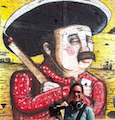The Film Forward team disembarks from a great week in the Imperial Valley. Photo by Jennifer Prediger.
Jennifer Prediger
The way Calexico and Mexicali play off each other gives reason to be excited about traveling to the Imperial Valley in California. The blending of names and place, people and ideas on the border of Mexico made this an ideal setting for Film Forward to visit. Our team met at LAX. Director Rachel Perkins came from Australia and Cindy Meehl from Connecticut, whose films, a narrative Aboriginal musical comedy and a documentary about a horse whisperer respectively, were our most important carry-on for the short flight. From Los Angeles, it takes about an hour to reach the Imperial Valley in a small, commercial airplane.
Flying over mountains and desert, you know you’ve arrived when verdant squares of agriculture appear on the ground below. It’s a desert cornucopia with yearly crop productions reaching over a billion dollars a year. This valley is one of the most bountiful in the country, growing a majority of winter fruits and vegetables for the U.S. and abroad. Desert heats allow for two growing seasons a year. Another notable yet unfortunate duality is the Imperial Valley has one of the nation’s highest unemployment rates at over thirty percent.
For a place that provides such sustenance to the country, this incongruity stands out. Even farmer’s markets are a rarity, as produce is shipped elsewhere for packaging and distribution. It was nice to travel here with a mission of giving something to this very generous region with the great connector of cinema. But as much as this trip was about building cultural bridges, the border crossing was still a distinct reminder of where countries are divided. The U.S. Border Patrol officiously asked the purpose of our visit to Mexico. One of us nervously blurted out, “Film screenings!”
“What kind of films?” he sternly asked. I heard myself quickly say, “Good ones.” What I would have said were I not afraid of authority figures carrying weapons was, “These films put you in someone else’s shoes and help you see things through their eyes. They’re stories about people overcoming insurmountable odds to achieve great things. These films are about human struggle and triumph. They’re cultural bridges and people who have seen them on each side of this line have been moved similarly.”
Regardless of my answer, we were allowed to travel across with relative ease. The films acted as passports, making us welcome wherever we went.
With screenings at schools, a museum, a library, a casino and a Stockmen’s Club, arts centers and Universities, conversations were sparked and ideas illuminated on both sides of the border, creating a ripple effect of newly engaged audiences and understanding.
Traveling this way puts the directors up-close to new audiences, where they experience first-hand how people react. Cindy and Rachel were generous in how they interacted with their audiences, sharing their journeys as filmmakers telling such personal and moving stories. Their desire to discuss the complex themes in their films and the filmmaking process seemed to effect audience members, many of who were meeting a filmmaker for the first time. The vision and courage both directors brought invoked laughter, tears and thoughtful conversation among their audiences.
Being with a new audience and talking with them, you get to experience the moment where the films reach people. Buck offered a vision for transformation. “Buck’s a real role model for people to see you can go on, you can overcome,” said Cindy in a conversation with a Calexico High School audience.
In Mexicali, Rachel spoke with filmmaking students about the “the wonderful thing of making art that also creates social change.” One of the students thanked the director, saying “this film teaches you to feel comfortable and proud of where you’re from and I think that’s something not a lot of Mexicans have.”
The impact of our journey continues to unfold. These screenings and conversations showed just how universal the medium of film is. Movies can change the world through worldviews and permeate even the thickest lines of demarcation.




